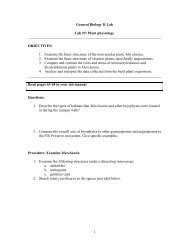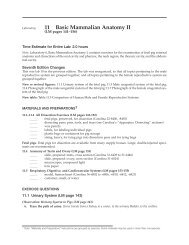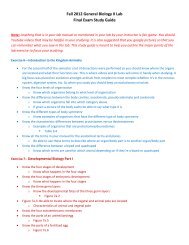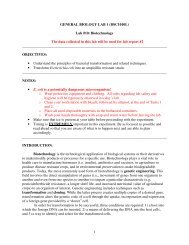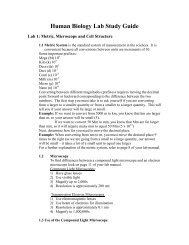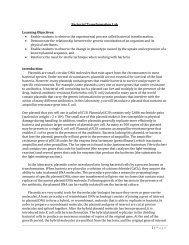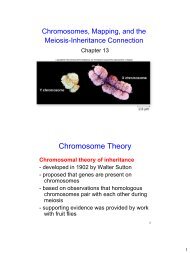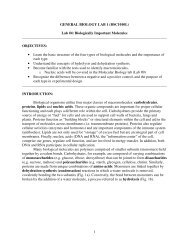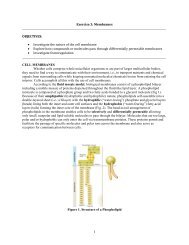Chapter 17. The origins of life and Precambrian evolution
Chapter 17. The origins of life and Precambrian evolution
Chapter 17. The origins of life and Precambrian evolution
You also want an ePaper? Increase the reach of your titles
YUMPU automatically turns print PDFs into web optimized ePapers that Google loves.
EVOLUTION/LECTURE1<br />
organic molecules, such as RNA, is arguably the point at which non-living matter<br />
came to <strong>life</strong><br />
4.2.- <strong>The</strong> hypothesis that an RNA molecule could replicate itself, serving as a simple<br />
proto-organism, is testable. If the hypothesis is correct, then we should be able to<br />
make a self-replicating RNA molecule in the lab. This has not been achieved today,<br />
although a great <strong>of</strong> deal <strong>of</strong> research is currently being conducted in this field.<br />
II: How do we get to RNA:<br />
5.- <strong>The</strong> problem <strong>of</strong> moving from an abiotic to a biotic<br />
environment<br />
5.1.- <strong>The</strong> RNA world has many attractive features, <strong>and</strong> it solves the problem <strong>of</strong> having<br />
to propose the advent <strong>of</strong> proteins before DNA existed to encode them. But an RNA<br />
world come with troubles <strong>of</strong> its own. Some critics have claimed that it simply<br />
pushes the problem <strong>of</strong> the origin <strong>of</strong> self-replication one step back. <strong>The</strong> issue<br />
here is simple: How could any RNA sequences come into being from an abiotic<br />
environment.<br />
5.2.- <strong>The</strong> general consensus is that the RNA world was probably not the first<br />
self-replicating system. This is because the likelihood <strong>of</strong> making RNA abiotically<br />
is too minute (see below heading 8 <strong>of</strong> this lecture) . <strong>The</strong> first issue that we need to<br />
address is how information-containing biomolecules were made from simple<br />
inorganic compounds. Where did these molecules come from<br />
6.- Where did the stuff <strong>of</strong> <strong>life</strong> come from<br />
6.1.- On September 28, 1969 a meteor entered the Earth's atmosphere over the town <strong>of</strong><br />
Murchison, Australia. Soon after, scientists collected some <strong>of</strong> the meteorites <strong>and</strong> carefully<br />
brought them back to the laboratory for chemical analysis. To their astonishment, the<br />
analyses showed that organic compounds were present in the interior <strong>of</strong> the rocks.<br />
In particular, the amino acids glycine, alanine, glutamic acid, valine, <strong>and</strong> proline were<br />
found in significant concentrations. <strong>The</strong>se amino acids are among the ones used by<br />
modern organisms to make proteins.<br />
6.2.- <strong>The</strong> amino acids they found were racemic; that is, they included roughly equal<br />
proportion <strong>of</strong> the D- <strong>and</strong> L-stereoisomers. By contrast, biological amino acids<br />
are almost purely <strong>of</strong> the L-form, <strong>and</strong> thus terrestrial <strong>life</strong> could not be the source <strong>of</strong><br />
the compounds the researchers found in the meteorites<br />
6.3.- Why were the Murchison meteorites significant <strong>The</strong> biomolecules <strong>of</strong> <strong>life</strong>, as well<br />
as their likely precursors, all require the elements carbon, hydrogen, oxygen, nitrogen,<br />
sulfur, <strong>and</strong> phosphorus in large amounts. If these building blocks could have<br />
been synthesized on the primitive Earth, then presumably they would have been<br />
available for condensation into larger biomolecules. But if they could not have been<br />
file:///E|/CH17-PRECAMBRIAN-SPRING-2008/CHAPTER%2017_SPR_2008.HTML[12/8/2011 2:57:27 PM]



